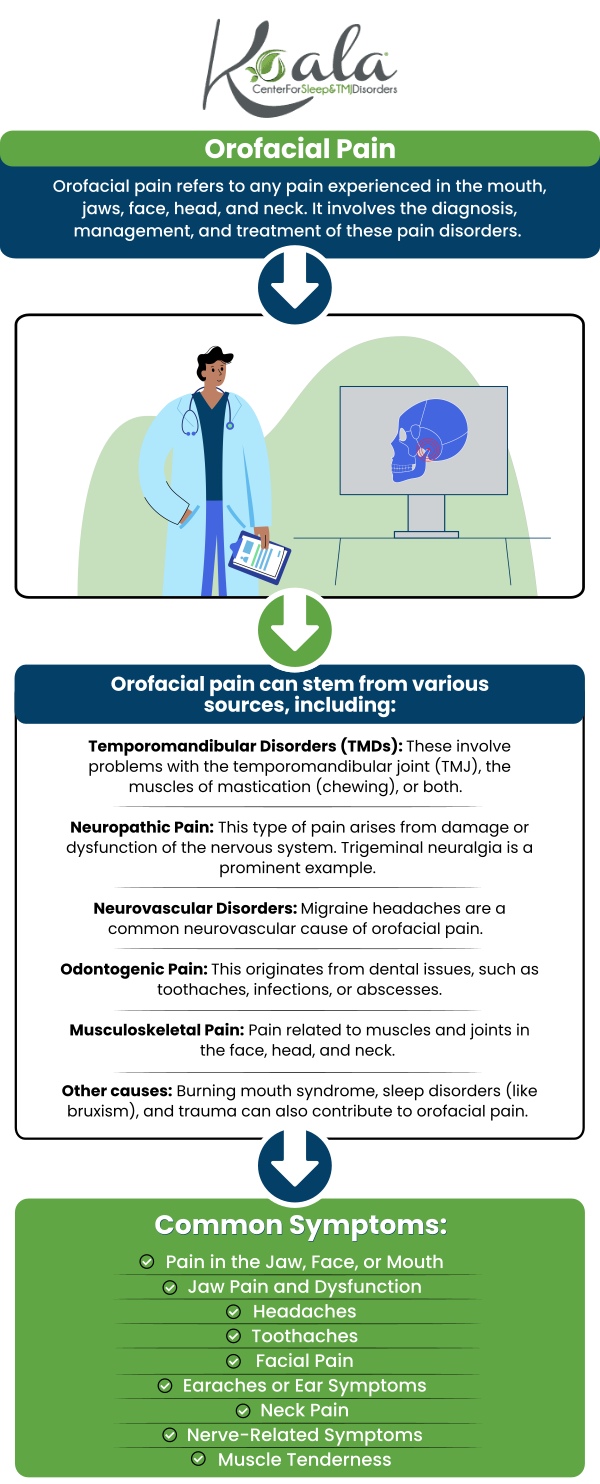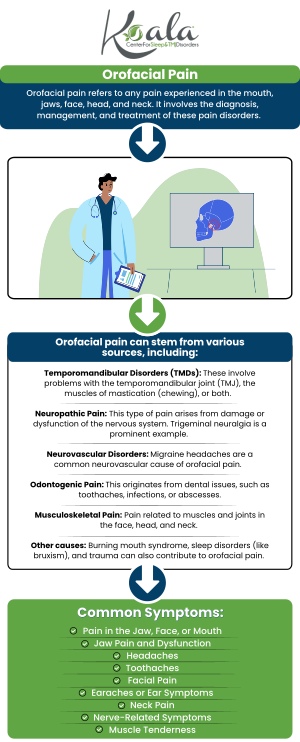When Should I Be Concerned About Orofacial Pain?
Orofacial pain is broadly classified as pain that is localized in the head and neck region, including the face and jaw. Pain in this region can be caused by a number of different factors including dental problems, TMJ disorders, infections, arthritis, bruxism, as well as neuropathic and neurovascular disorders, making it sometimes difficult to determine the exact cause of the pain being experienced. Come to Koala® Center For Sleep & TMJ Disorders for treatment. For more information contact us or book an appointment online. We have convenient locations across the U.S. in Bloomington IL, Peoria/Dunlap IL, El Paso TX, and Wausau WI.




Table Of Contents:
What conditions may have orofacial pain as a symptom?
What does orofacial pain feel like?
How do you get rid of orofacial pain?
When should I be concerned about orofacial pain?
Orofacial Pain impacts several areas located on the head, there are a few different potential conditions that are commonly associated with causing pain in one or more of the orofacial features. The most common conditions are temporomandibular joint disorder, neuropathic and neurovascular disorders, headache or sleep disorders, as well as jaw movement disorders. TMJ disorders are more often than not the culprit for orofacial pain, including Jaw Joint and Muscle Sprain/Strain (JAMSS), myofascial pain, TMJ disc derangement, and TMJ degenerative disease. TMJ disorders lead to localized pain in the jaw joint and the surrounding muscles that are responsible for controlling the movement of the jaw and often develop due to a jaw injury, arthritis, or in those who tend to clench or grind their teeth.
ince there are several different potential causes for orofacial pain, the symptoms may vary a bit as well. Many orofacial pain conditions will feel like aching in the jaw, with persistent headaches and dull or sharp pain located behind the eyes. It is also common to experience neck pain, ear pain, jaw joint pain, dental pain, and sensations of burning or stabbing in the face. The pain can range quite a bit in severity and localization, with it being more common that the pain is experienced in more than a single small localized spot. The pain itself can often be described as sharp and electric or even feel similar to a mild consistent buzzing. Orofacial pain that is caused by TMJ disorders will likely worsen when the jaw joint is being used, particularly while eating, and often feels as if the jaw is locked or catching in place while opening and closing.
The most effective treatment option to treat the cause as well as manage the symptoms will depend on the disorder or condition that is being treated, with injuries to the orofacial area causing trauma often requiring a combination of temporary pain medication, dental care, physical therapy, and sometimes chiropractic adjustments. Common treatments for TMJ disorders include muscle relaxers for temporary comfort, mouth guards to prevent involuntary clenching or grinding while sleeping, and often implementing jaw-specific stretches to reduce tightness of the muscles and joints involved. TMJ disorder treatment is often provided by dental providers or physicians who have specialized in TMJ disorders and conditions. Another type of orofacial pain is bruxism, which results in frequent migraines, and can also be treated using mouthguards in combination with physical therapy and pain medications. Neck injuries are also known for causing orofacial pain, which can also be treated using a combination of pain medication and physical therapies, and sometimes requiring a chiropractic adjustment or implementation of a mouth guard.
As soon as you start experiencing pain it may be worth having it assessed by a medical professional to limit any suffering as quickly as possible, but you should definitely seek medical attention if the pain suddenly worsens or is associated with dizziness, shortness of breath, chest pain, difficulties with vision, and the presence of any swelling in the neck, face, or head. There are some cases where orofacial pain is indicative of a tooth infection that should be treated as soon as possible to prevent it from spreading or causing any long-term damage, with associated symptoms including radiating heat that starts in the jaw and extends to the temples, worsening in pain as it spreads. Regardless of the cause for the pain, it is important that any pain that is unusual or hasn’t previously been diagnosed should be checked by a health care provider right away to ensure that the problem can be treated effectively and that there is no unnecessary suffering for the patient.

Additional Services You May Need
▸ KoalaKIDZzz®
▸ Sleep Apnea
▸ Snoring
▸ TMJ Disorder
▸ Fatigue
▸ Sleep Disorders
▸ Weight Loss
▸ CPAP Alternative
▸ Oral Appliances




